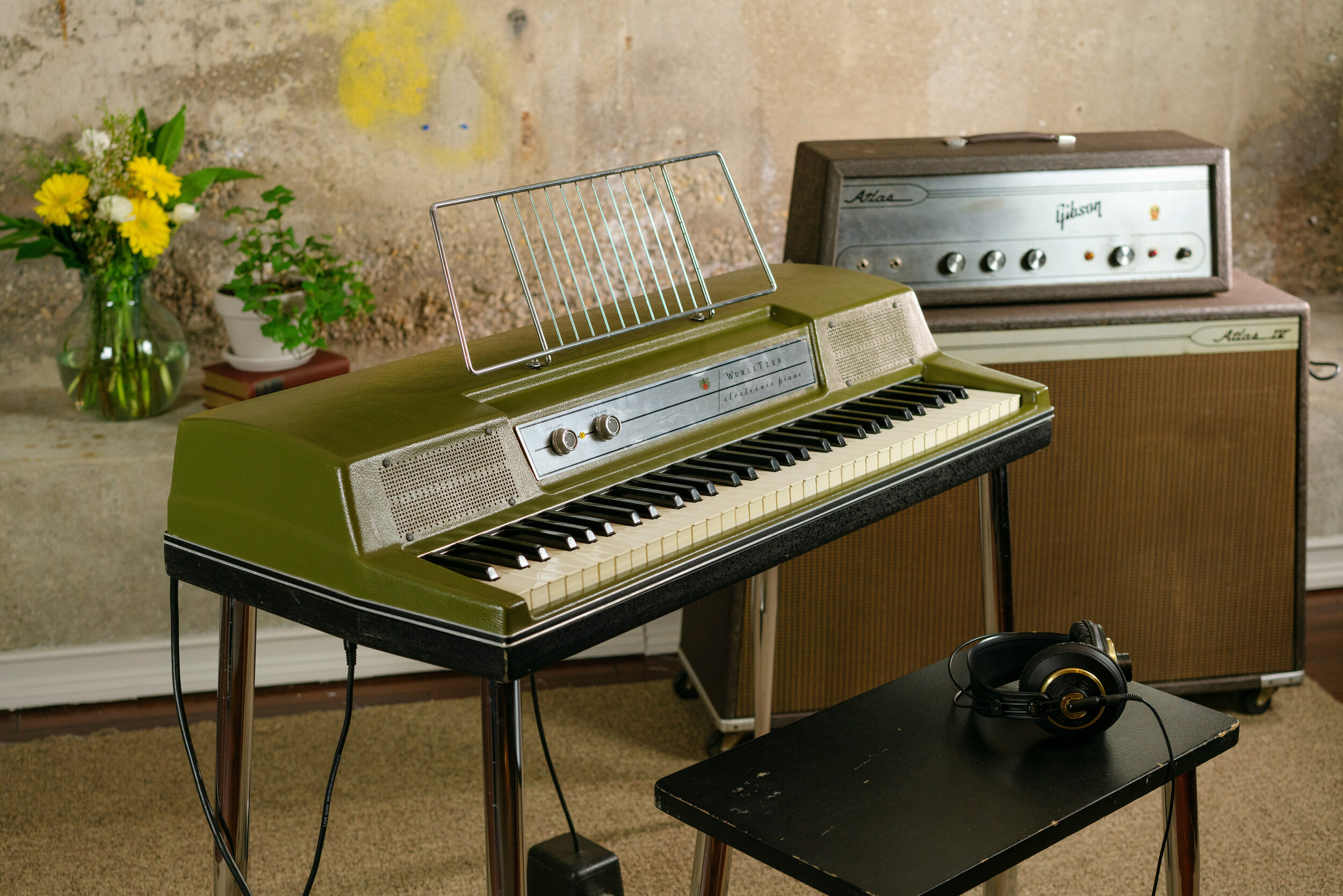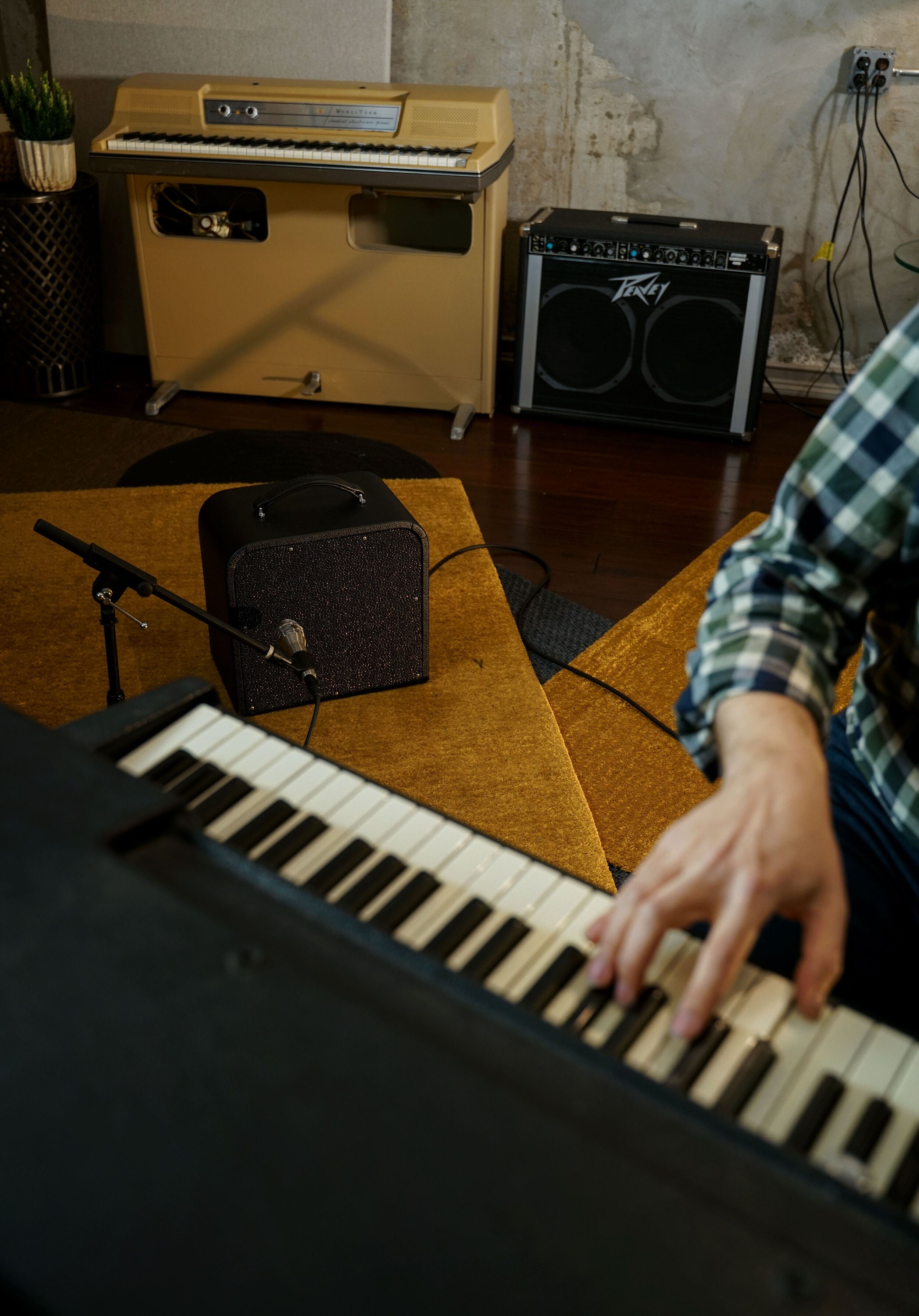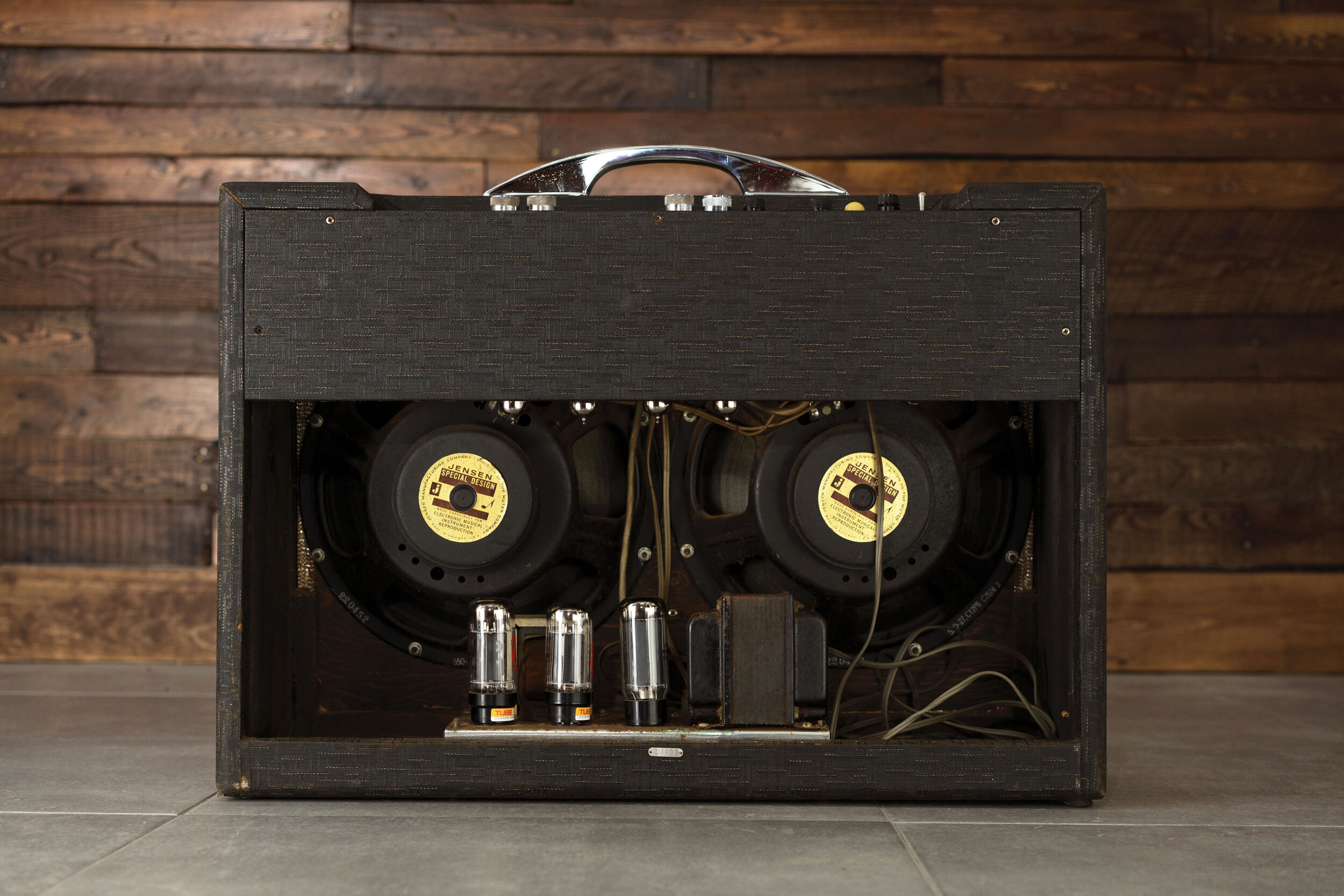How to replace a Wurlitzer electronic piano reed
Replacing a reed on your Wurlitzer electronic piano is not difficult. There are a few important things to keep in mind for the best results. One, the reed needs to be as close to perfectly centered in the ‘comb-shaped’ pickup as possible. Two, the reed has a bit of wiggle room on the reed screw, and where the reed sits (favoring forwards or backwards) impacts the intonation. Three, the tightness of the reed screw matters. Four, there are different sized reeds for the different models of Wurlitzer electronic pianos, as well as the different registers of your piano. Five, the solder ‘pyramid’ on the tip of the reed, which is the main area of tuning the reed, should be a symmetrical pyramid for the best sound (but this may not be of importance to you if you are buying a pre-tuned reed).
What do Jack Springs do? And, What are they?
The jack spring is a small, thin gauged spring about 1” tall that sits between the whip and the fly on your 140 or 200 series Wurlitzer. These are also in upright and grand pianos and come in a few sizes depending on the model of your piano/keyboard.
What to Look for When Buying a Wurlitzer 200 or 200a
Vintage instruments are the ‘real thing’ and were built to a different—possibly better—standard than modern ones. But let’s face it: some of them have been around the block, multiple times. And why not? They are decades old: someone should have enjoyed them. Hopefully, that person didn’t enjoy them too much and in the wrong way. (The sheet music holder is not a party convenience tray, necessarily.) For this reason, the vintage instrument market can be a scary and confusing place. Buying a Wurlitzer 200 or 200A is a prime example. Prices range, and if you have never have looked inside one, you possibly don’t know what to look for.
What should come with my Wurlitzer 200 or 200a?
Wurlitzer 200 and 200a keyboards came with some essential accessories and parts, as well as some that were optional at the original time of purchase. If you are less familiar with a Wurlitzer 200 series keyboard, you might overlook something that is critical and you’ll want to have. For the sake of this article, we will be discussing exterior items and accessories, not internal mechanicals, and will be focusing on the 200 and 200a. However, a lot of this information can be applied to the rest of the 200 series (such as 203, 210, 214, 206 and so on).
Why are some of the Keys on my Wurlitzer 112 lower than others?
In this article we are going to discuss 112 hammers that are significantly lower in height than other keys. Also these keys will not hit and will feel ‘stuck’. This sometimes happens when the Wurlitzer 112 has been moved around, placed on its back, or dare I say, placed upside down. This can also happen simply when a key is removed to be worked on. Because the fly (or jack) is different on the 112, it is connected to the whip in a way where it has a more free rotation than in later models. The only thing that is keeping the fly in place on the hammer butt is the back end of the regulating screw.
Are the jack springs weak or bad in my Wurlitzer 200?
Let me answer your question with another question, have they ever been changed before? Then, yes, they’re weak, and probably bad. In all seriousness, once installed, a jack spring (which is a pretty thin gauge) is constantly in use because it’s always under tension. Fast forward 50 years and you have a spring that is likely close to being worn out. Add rust or oxidation and they’re definitely worn out.
What do Jack Springs do? And, What are they?
The jack spring is a small, thin gauged spring about 1” tall that sits between the whip and the fly on your 140 or 200 series Wurlitzer. These are also in upright and grand pianos and come in a few sizes depending on the model of your piano/keyboard.
Key Height, Key Dip and My Wurlitzer
Part of what makes a Wurlitzer electronic piano feel so great (and so piano-like) to play is its action design. Unlike the simple action of a Rhodes keyboard (which merely consists of a key and a hammer) a Wurlitzer’s action has multiple points of contact and moving parts all working together to smoothly transfer the motion of the player’s touch to the hammer striking tone generator. Like all other pianos, a Wurlitzer electronic piano’s complex action assembly is driven by the key. This sounds obvious, but it is important to note that the key sits on two felt punchings and it is at these points where the first critical action adjustments are done.
How to Tell If Your Speaker Is Blown
The sound of a blown speaker is pretty tell-tale - fuzzy, distorted crunchy sound that may be roughly reproducing the signal you are sending through it or making no sound at all.
There are a few scenarios that can cause a speaker to malfunction. A speaker can sustain physical damage to the cone or even the voice coil. Sometimes the damage is obvious. In other cases, the speaker may look fine, and the distortion may be so subtle that you could be wondering if your amplifier is actually at fault. In this article, we’ll share our tips on how to determine whether your speaker or your amp is to blame.
What is the difference between a Wurlitzer's headphone output and aux output?
Although both the Wurlitzer’s headphone out and aux out are (obviously) outputs, they tap the signal from very different points in the circuit. In this article, we’ll describe the differences between the two outputs, so that you can choose which one is better for your application.
On the Wurlitzer 120 Service Manual
By the time the 120 was released, the Wurlitzer electronic piano had been available for several years. It is, in the words of the service manual’s Introduction, “lighter weight, smaller, more attractive, and contains a number of other improvements over former models.” We’re not sure if the 120 is in fact “more attractive” (the 112’s cool-toned splatter finish is amazing and we could never pick favorites), but the 120 definitely has a smaller form factor. And although it has a lot of similarities with the 112, it definitely warrants its own service manual.
Essential Accessories for Wurlitzer Electronic Pianos
A Wurlitzer is a self-contained instrument. Thanks to its onboard speakers and onboard amplifier, all you truly need to get started playing a Wurlitzer is the Wurlitzer itself. No external amps or accessories required!
Of course, there are a few pieces of gear that will make your Wurlitzer perform at its fullest potential. Here’s what we recommend:
On the Wurlitzer 700 Service Manual
The Wurlitzer 700 is the console version of the Wurlitzer 120, and its manual is very similar to the 120 manual. The 700 is the same keyboard, except that it is housed in a more traditional cabinet that resembles a spinet piano. The primary differences between the two manuals is that the 700 manual has photos and diagrams of the console.
Refinishing Old Veneer: How we repainted a Wurlitzer 700
Although we love a good original-condition Wurlitzer, we also refinish them occasionally. When refinishing, we try to choose models that are in poor condition and do not have any particular historical significance. (More on our criteria for modding keyboards here.) This keyboard definitely fit the bill.
The Wurlitzer 120 Pilot Light: a Neon Glow Lamp
The pilot light in all Wurlitzer 120 Electronic Pianos is unique. You may notice that when you turn on your 120 the lamp takes a few extra seconds to turn on. Likewise, when turning the amp off the pilot light may take a few seconds to turn off. It kind of does its own thing. That is because the pilot light (or lamp) is a neon glow lamp. Just when you thought the 120 couldn’t get any cooler, it has its very own neon sign to let you know when its on.
Common Amplifier Malfunctions: The amp smells like it's burning.
There are two major reasons why an amp might smell like it’s burning:
The amplifier is covered in dust, which is in fact burning from the heat of the tubes
The amplifier is malfunctioning and a component is burning
If you have any doubt whether your amplifier is burning, you should turn it off and unplug it right away. However, you may be asking yourself, am I overreacting? Is it correct to be concerned about this burning smell? Or do old amps always smell this way?
On Troubleshooting
Troubleshooting a vintage amplifier involves a skillset that is distinct from designing new circuits. The prime advantage of troubleshooting — the fact that the circuit has already been created for you, in its entirety — is also its biggest challenge.
Common Tube Amp Malfunctions: My amp doesn't turn on.
The circuitry that turns the amp on and off is very simple: pretty much just some wiring that provides line voltage to the transformer. More commonly, this wiring is in great shape, voltage passes through it with no problem at all, the amp turns on, all the bad components inside receive all the power that the circuit can offer, and then the amp starts malfunctioning.
How to Tune a Wurlitzer Electronic Piano Reed
A Wurlitzer electronic piano is a unique instrument that uses a piano-like action assembly to strike metal reeds of various pitches to make sound. Like traditional acoustic pianos, a Wurlitzer electronic piano (or EP) has an action assembly with wooden hammers, keys, whips and dampers. However, the tone is generated when the hammer strikes a metal reed, whereas on acoustic piano a string is being struck. One simple principle remains the same though: longer or larger tone generators make lower-pitched notes, and shorter or smaller tone generators make higher-pitched notes.
How to De-Rust Wurlitzer Legs (or Any Oversized Item)
Chrome Wurlitzer 200 and 200a legs are often rusty. Unlike earlier models, the 200 and 200a do not have built-in leg storage. And chrome legs are often not stored as conscientiously as the keyboard itself — or, even if they were originally, they’re prone to rolling away (probably, as luck would have it, into the dampest corner of the room). Anyway, we’re happy anytime the original legs are present, regardless of their condition. (Without the built-in storage method, they are very easy to lose over a span of 35+ years!) And if they are covered in rust — good news! — it is easy to remove.
What speaker impedances can I safely connect to my tube Wurlitzer electronic piano?
Every tube amplifier has a preferred speaker impedance: usually, this is something in the neighborhood of 4 Ω or 8 Ω. The preferred speaker impedance of tube Wurlitzers are as follows:
On reading Wurlitzer patents
What is a patent? A patent is a form of compromise. When you patent an invention, you must describe it in detail: specifically, enough detail that someone with a background in your industry would understand how to recreate your invention just by reading the patent application. In return for this valuable information, you are given the exclusive legal right to make and sell your product for a certain number of years. If someone else makes or sells your product during the time period covered by your patent, you have the power to sue them for patent infringement.




















